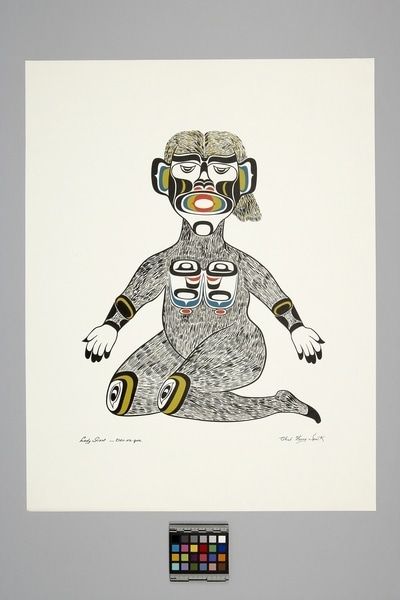Lady Giant, Dzu-Nu-Gwa Item Number: Nb3.1405 from the MOA: University of British Columbia

Description
Woman sitting in frontal position with her arms outstretched and her knees to the right in profile. Her entire body is covered in dash lines. Her hair is yellow and black dash lines with one tuft coming from below her left ear. Her hands are outlined in black and are left white. Her foot has a thick black line up to the toes. The knees have ovoids in black and green-yellow with an eye in them. The breasts are stylized in white u forms, black ovoids, blue-green split u's, and red spots. Her face is white with multi-coloured ovoids, s forms, u forms and split u's. Black inscription below image. The print is on vertically rectangular, off-white paper.
History Of Use
Northwest Coast print making is a relatively new art form, which began in the late 1940's, but did not develop until the late 1960's. The establishment of the Northwest Coast Indian Artists Guild, in 1977, aided the implementation of standards in limited addition runs and various aspects of quality control. Silk-screen prints have been used to portray traditional and contemporary themes, as well as, to make personal statements. Kwakwaka'wakw artists have, in general, preferred to work with traditional crest designs and mythical themes. More colours are used by Kwakwaka'wakw artists than are used by northern Northwest Coast artists, and the images are composed of many small elements combining into relatively realistic forms.
Iconographic Meaning
Since only females wore labrets, this is a way of distinguishing women.
Cultural Context
contemporary art
Narrative
Nb3.1335 to Nb3.1343 were given to Audrey Hawthorn in 1973. This collection of Henry Speck prints is from an unnumbered collection probably printed in the 1960's.
Item History
- Made by Chief Henry Speck (Maker) in British Columbia, Canada during 1962
- Collected during 1973
- Owned by Audrey Hawthorn before June 21, 1976
- Received from Audrey Hawthorn (Donor) on June 21, 1976
What
- Name
- Lady Giant, Dzu-Nu-Gwa
- Identification Number
- Nb3.1405
- Type of Item
- Manufacturing Technique
- silkscreened
- Overall
- height 62.3 cm, width 48.2 cm, depth 0.1 cm
Who
- Culture
- Kwakwaka'wakw
- Creator
- Chief Henry Speck (Maker)
- Previous Owner
- Audrey Hawthorn
- Received from
- Audrey Hawthorn (Donor)
Where
- Holding Institution
- MOA: University of British Columbia
- Made in
- British Columbia, Canada
When
- Creation Date
- during 1962
- Collection Date
- during 1973
- Ownership Date
- before June 21, 1976
- Acquisition Date
- on June 21, 1976
Other
- Item Classes
- works on paper
- Condition
- fair
- Accession Number
- 0309/0015